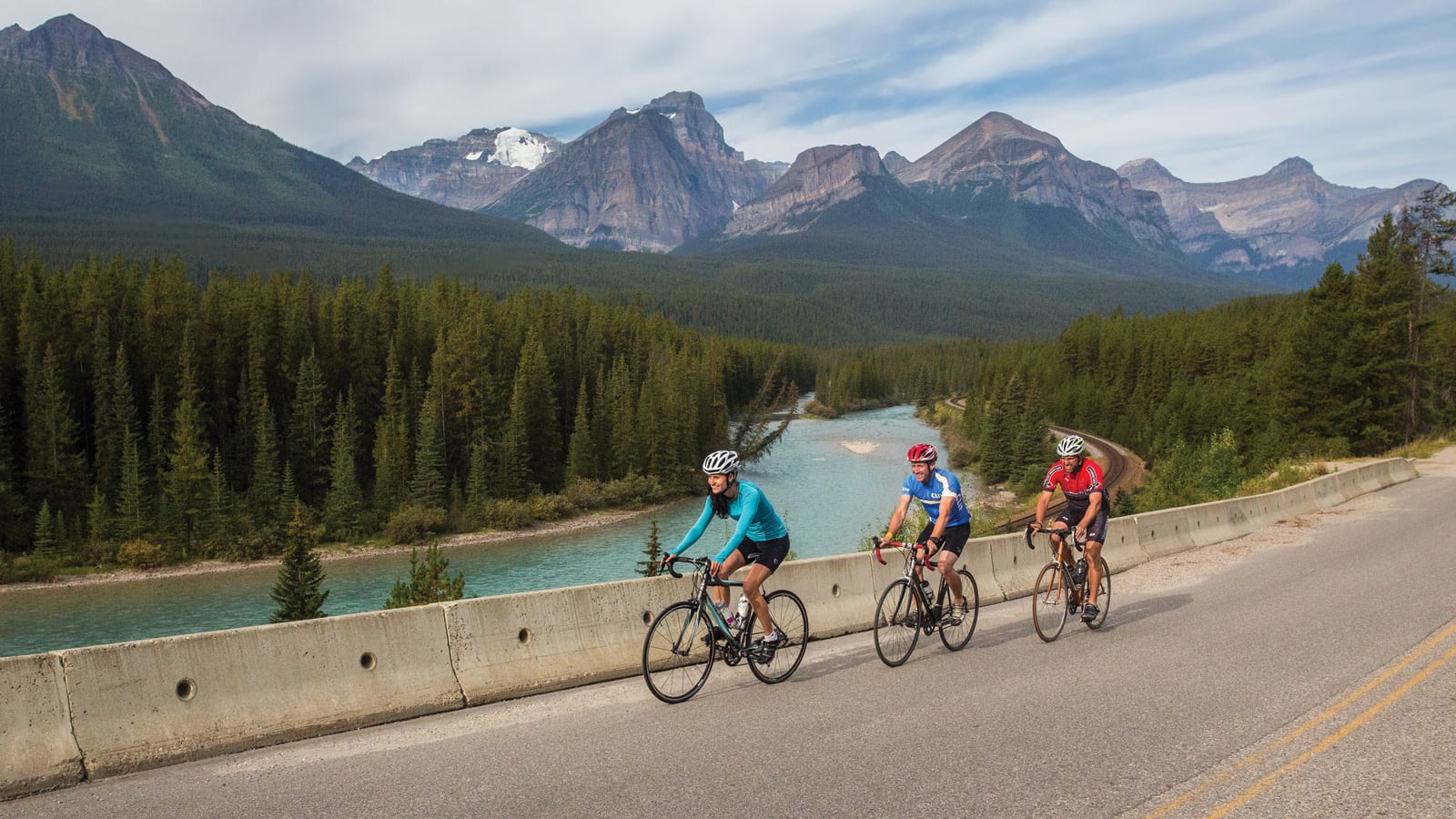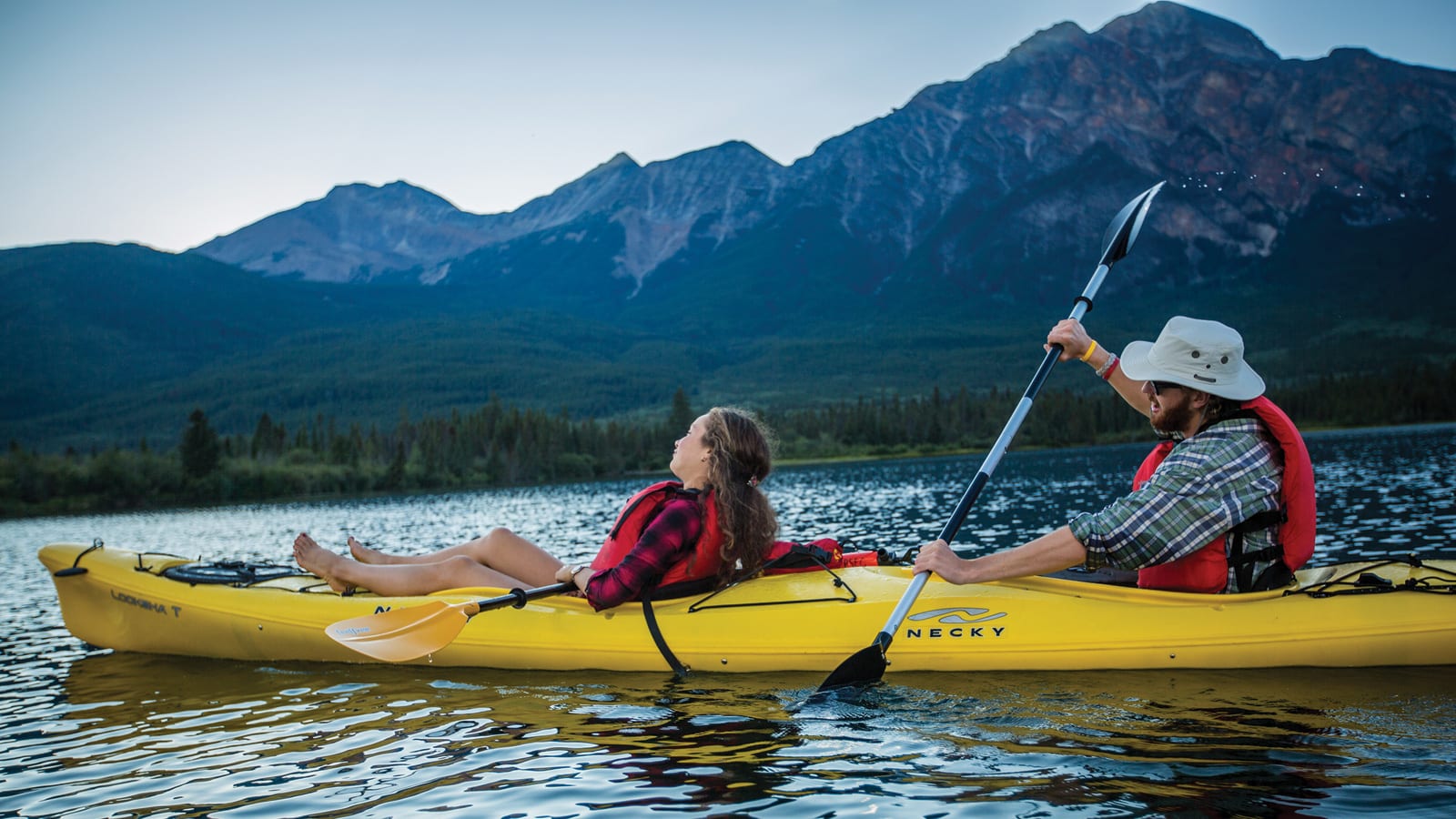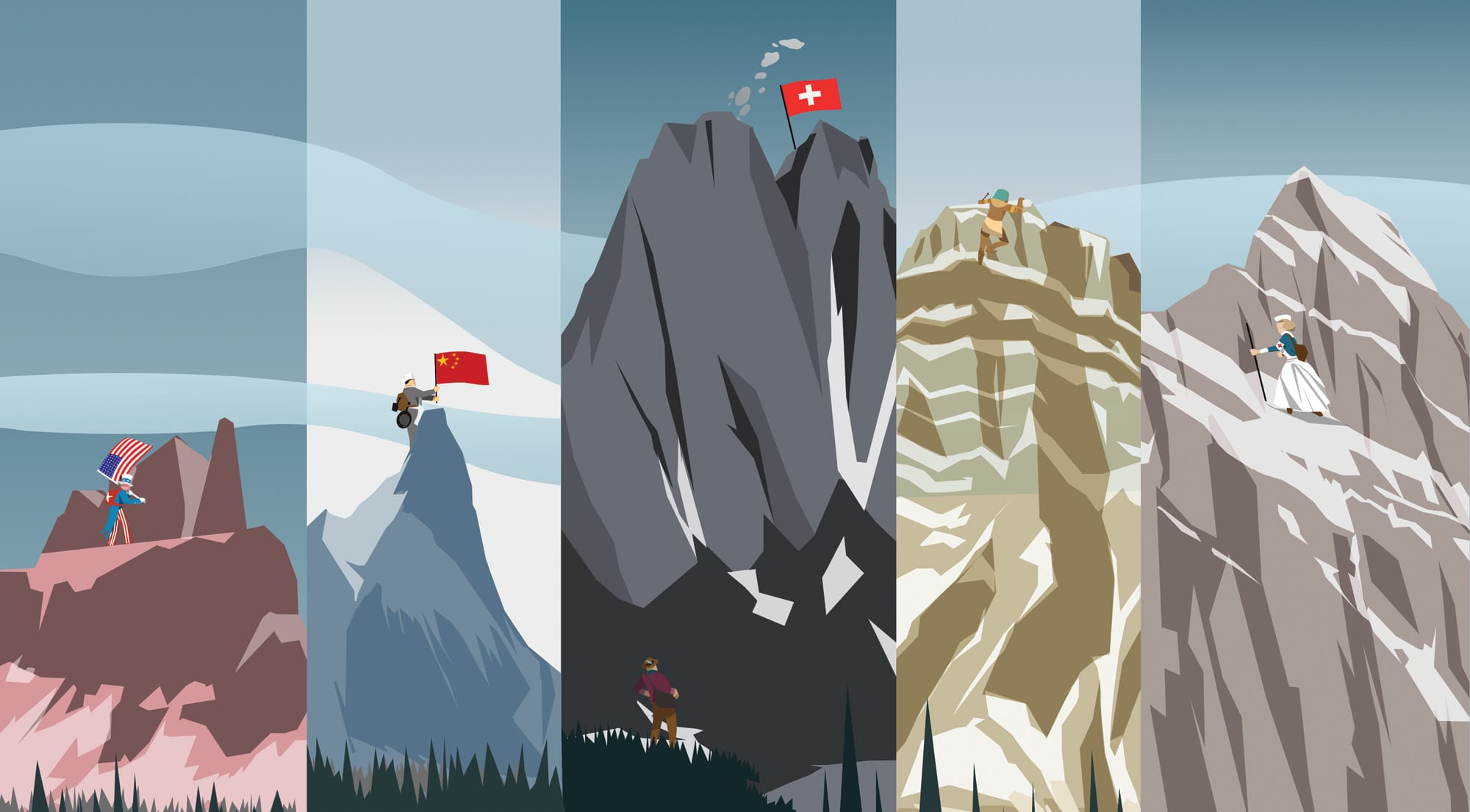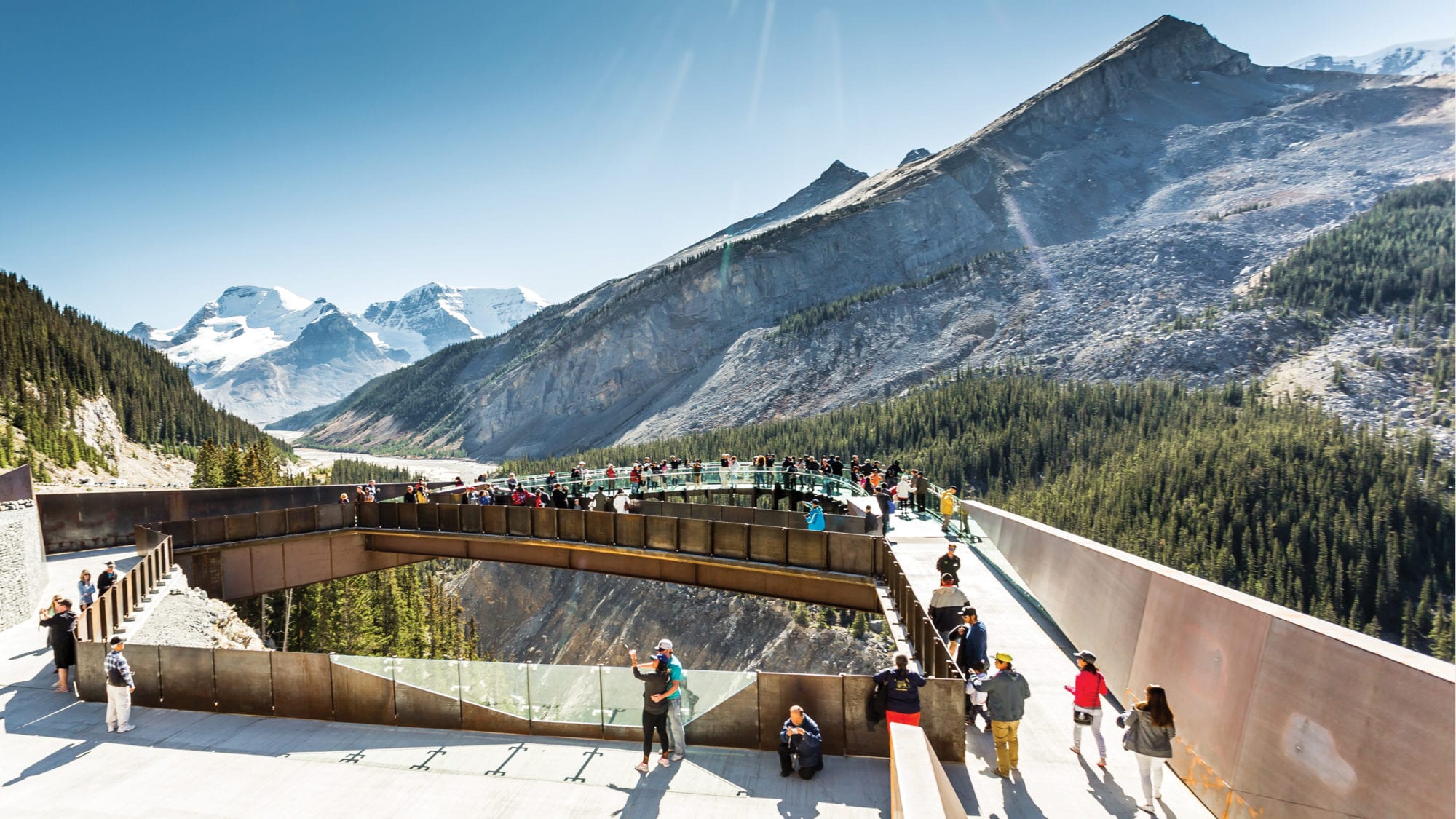Whether you’ve driven through the Rocky Mountains once or a thousand times, the scenery is always astonishing. Head west and watch the landscape transform from flat prairie to rolling foothills to giant peaks. The experience never gets old—and there’s always a new way to fall in love with the Rockies.
ROAD TRIP!
Because the best way to see the Rockies is by car, with a few fun pit stops along the way. But remember to double-check that your route is open before leaving. Some roads or attractions may still be closed
Hwy 93: Lake Louise to Jasper
This is one of the most beautiful drives in the world. With hundreds of peaks and glaciers, stunning mountain lakes and powerful waterfalls, each turn presents more outstanding scenery than the last. Plan to pull over a lot. Along the 230-kilometre stretch of road, also called the Icefields Parkway, you’ll find the Columbia Icefield Discovery Centre, where you can tour the Athabasca Glacier. Farther north, walk out along the glass-bottomed Skywalk and gaze 280 metres down to the canyon floor. As you navigate the enormous hairpin turn aptly called the Big Bend, give a nod to the 600 men who first built the highway—mostly by hand—in the 1930s as a government make-work project.
Hwy 93A: in Jasper National Park
Known to locals as the “old highway,” the stretch of 93A south of Jasper has fewer vehicles than Hwy 93, but offers the same jaw-dropping scenery. Once part of the original Banff/Jasper route, the meandering roadway begins about six kilometres south of Jasper and runs parallel to the Icefields Parkway until meeting up again with Hwy 93 near Athabasca Falls. Avid hikers often use the road to access gorgeous day hikes or overnight adventures at backcountry lodges. Though directions may not pop up on Google Maps, you’ll find loads of local signage pointing the way to top spots. But you don’t even have to get out of the car to enjoy this 30-kilometre detour down the old highway—gorgeous peaks and glaciers dot the route through Jasper National Park. Be sure to plan ahead though: Hwy 93A is closed from November to April.
Hwy 11: Rocky Mountain House to Saskatchewan Crossing
It may be the road less travelled, but that doesn’t mean it’s any less magnificent. Heading west from the small town of Rocky Mountain House, you’ll marvel as the vista morphs from foothills to mountains. At Nordegg, a former mining town turned outdoor adventure hot spot, head out fishing or hiking for the day. A little farther west, pull over and unpack a picnic at Abraham Lake, a vast man-made lake filled with natural mountain-blue water. All along the 180-kilometre route, watch for bears, moose and other wildlife. At Saskatchewan Crossing, where the Mistaya and Howse rivers meet the North Saskatchewan, turn right to check out Jasper, or turn left to go to Lake Louise.
MORE TO READ
Things to do in David Thompson Country
Hwy 1a: Bow Valley Parkway in Banff National Park
While every route through the Rocky Mountains is scenic, this stunning 50-kilometre stretch between Banff and Lake Louise is off the charts. Take a few hours to meander down the Bow Valley Parkway or Hwy 1A, and pull over at some of the many scenic lookouts for a picnic, a photo op or a breath of crisp mountain air. Unlike the more travelled Trans-Canada Highway across the river, there are no wildlife fences on the 1A. So be on the lookout for animals while driving the parkway or walking among the aspen trees. You can also pedal the area: The eastern section of the highway (to Castle Junction) is currently closed to vehicles, perfect for exploring on two wheels. Check out the popular hike at Johnston Canyon or bask in the fall colours.

TCH Hwy 1: Lake Louise to Revelstoke
This 230-kilometre route takes you through Canadian railway history, across thrilling mountain passes and into quirky towns. Keep an eye out for the Spiral Tunnels, which have enabled trains to navigate Kicking Horse Pass since 1909. Your first stop west of Lake Louise is the little town of Field, B.C., with its legendary Truffle Pigs bistro. Next, pop into Golden to hit up the museum—to learn about early explorers—or the art gallery to see pieces by local artisans. At the Rogers Pass Discovery Centre in Glacier National Park, learn how the railway was built through the mountains. And in Mount Revelstoke National Park, east of the town of Revelstoke, go for a stroll amidst ancient forest along the Giant Cedars Boardwalk.
Hwy 93/95: Cranbrook to Radium Hot Springs
In British Columbia, this gentle 144-kilometre drive between the Rocky and Purcell mountains takes you past rushing rivers, long beautiful lakes, golf courses and plenty of bighorn sheep. From the outdoorsy town of Cranbrook, wind your way north to explore the Kimberley Nature Park, which boasts hiking adventures ranging from easy to very challenging. Farther on, hit the links, dip into the hot springs at Fairmont and Radium or walk the beaches of Lake Windermere. In the town of Invermere, peruse local boutiques before heading to Radium, just outside Kootenay National Park, to drive alongside remarkable cliffs. Slow down and look up to count the bighorn sheep. From Radium, you can go east to head back to Alberta or turn north toward Golden, B.C.
DRIVING TIPS
1 Before driving through the Rockies, make sure your vehicle is in tip-top shape. A breakdown could mean a long wait, due to accessibility challenges.
2 Fuel up before setting off so you have a full tank of gas or charge for your EV.
3 Keep your eyes on the road: You’ll still see jaw-dropping views as you safely drive around bends.
4 Take advantage of the frequent lookouts on many routes to pull over and gaze at the peaks.
5 The speed limit is lower in national parks due to abundant wildlife. Slow down, clear your windshield for visibility and scan both sides of the road for animals.
6 The biggest risk for hitting wildlife is from October to January, between 7 p.m. and 11 p.m. In Alberta, November is the peak month for wildlife-vehicle collisions and most of those collisions (80 percent) involve deer.
7 Ease up on the gas pedal and enjoy every kilometre of the Rockies’ glorious scenery.

PADDLE, PEDAL, POOL
Three unique ways to experience the best of the Rockies.
Canoe on Pyramid Lake: Paddling is optional in Wild Current Outfitters’ big cedar-strip canoe. While guides paddle across the lake, guests can row or sit back and look for osprey, loons, beavers, wolves, moose and bears. Hop out on shore for a snack and a primer on grizzly and black bear tracking.
Soak in Fairmont Hot Springs: After a long drive or hike, relax with a soak in the pool at Fairmont Hot Springs.* With naturally heated waters full of minerals, hot springs are known to boost metabolism, soothe sore muscles and improve blood circulation. The mountain views are pretty good for you too.
MORE TO READ
Fat biking in the Rockies: your new favourite winter sport
Ride the Great Divide: From the Great Divide trailhead near Lake Louise, hop on a mountain bike for a gentle 20-km ride on the mostly flat trail that used to be Highway 1A. You’ll see the old Great Divide arch, marking the border between Alberta and B.C. After posing for the requisite pictures at the ’60s-era signage, you may want to venture a few clicks farther into B.C.’s Yoho National Park.
*Check fairmonthotsprings.com for current operating hours.
HOW TO CLIMB A MOUNTAIN
Whether you go on a little hike or shoot for the top, Parks Canada advises you plan ahead, know your limits and bring proper gear.
1 Check conditions before you head out and have a plan of where you’re going. Share it with someone at home, in case you run into trouble.
2 Make sure your cell phone is fully charged —and always pack a backup battery in case of emergencies.
3 Ensure everyone in your party has the physical ability to tackle the chosen route. Don’t wear earphones. Stay alert at all times.
4 Wear comfortable hiking shoes or boots, a hat, sunscreen and a few layers of clothing—the weather can change quickly in the mountains. Bring lots of water and snacks and a first aid kit.
5 Make a lot of noise on the trail to keep bears away, but also make sure you have bear spray.
6 Don’t litter or leave any garbage behind. If hiking with Fido, always use a leash and clean up after him.

PICK A PEAK
Must-see mountains and their hidden histories.
Castle Mountain
Banff National Park
Elevation: 2,766 m
Best views: Hwy 1, Hwy 93
In 1946, Prime Minister William Lyon Mackenzie King abruptly renamed Castle Mountain to Mount Eisenhower the day before a visit by the future American president. People were outraged. In 1979, the mountain was finally re-renamed—but its eastern elevation is still called Eisenhower Peak.
Ha Ling Peak
Bow River Valley
Elevation: 2,408 m
Best views: Hwy 1, 1A, 742
In 1896, Ha Ling, a cook in a mining camp, bet his coworkers $50 he could climb the mountain, plant a flag and be back in Canmore within 10 hours. Word is he did it in five-and-a-half. Another version of the story says Lee Poon was the Chinese cook who won a $10 bet.
MORE TO READ
Where to see amazing animals in the Alberta Rockies and beyond
Mount Assiniboine
Alberta-B.C. border
Elevation: 3,618 m
Best view: Hwy 742
In the late 1800s, a geologist was watching a cloud trail away from the massive mountain and was reminded of smoke leaving a tipi in an Assiniboine camp. Mount Assiniboine is also called “the Matterhorn of the Rockies” because it resembles the famous peak in the Swiss Alps.
Mount Chephren
Banff National Park
Elevation: 3,266 m
Best view: Hwy 93+
In 1918, there was concern too many mountains were called “Pyramid.” A Jasper-area mountaineer suggested this Pyramid Mountain be renamed for a pharaoh that built one of the Great Pyramids. Chephren was the fourth pharaoh of the Fourth Dynasty of Egypt in the 16th century BC.
Mount Edith Cavell
Jasper National Park
Elevation: 3,363 m
Best views: Hwys 16, 93
Edith Cavell was a British nurse who helped Allied soldiers escape German-occupied Belgium in WWI before being executed by the Germans. A few months later, in March 1916, the peak originally called Mount Fitzhugh was renamed to honour the courageous nurse who’d never set foot in Canada.

SAVE WITH AMA
Pack your membership card before hitting the road to the Rockies!
• Save $10 on annual family Parks Canada Discovery passes
• Get AMA’s Best Price Guarantee on top mountain hotels.
• Stock up on hiking and camping gear at Altitude Sports through the AMA e-Store and earn 4% in reward dollars
• Save 15% on admission to Canadian Rockies Hot Springs in Radium, Jasper and Banff*
• Get a bird’s-eye view on the Jasper SkyTram; members save 15%
*Check hotsprings.ca for current operating hours.
